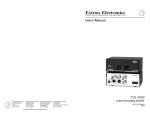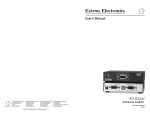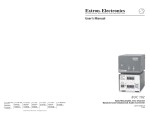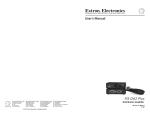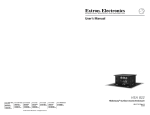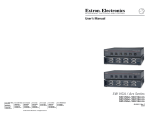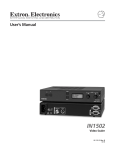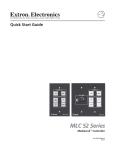Download Extron electronics IR 452 User`s manual
Transcript
User’s Manual IR 452 www.extron.com Extron Electronics, USA Extron Electronics, Europe Extron Electronics, Asia Extron Electronics, Japan 1230 South Lewis Street Anaheim, CA 92805 USA 714.491.1500 Fax 714.491.1517 Beeldschermweg 6C 3821 AH Amersfoort The Netherlands +31.33.453.4040 Fax +31.33.453.4050 135 Joo Seng Road, #04-01 PM Industrial Building Singapore 368363 +65.6383.4400 Fax +65.6383.4664 Kyodo Building 16 Ichibancho Chiyoda-ku, Tokyo 102-0082 Japan +81.3.3511.7655 Fax +81.3.3511.7656 © 2005 Extron Electronics. All rights reserved. Remote Control 68-1178-01 Rev. A 09 05 Precautions Safety Instructions • English This symbol is intended to alert the user of important operating and maintenance (servicing) instructions in the literature provided with the equipment. This symbol is intended to alert the user of the presence of uninsulated dangerous voltage within the product’s enclosure that may present a risk of electric shock. Caution Read Instructions • Read and understand all safety and operating instructions before using the equipment. Retain Instructions • The safety instructions should be kept for future reference. Follow Warnings • Follow all warnings and instructions marked on the equipment or in the user information. Avoid Attachments • Do not use tools or attachments that are not recommended by the equipment manufacturer because they may be hazardous. Consignes de Sécurité • Français Ce symbole sert à avertir l’utilisateur que la documentation fournie avec le matériel contient des instructions importantes concernant l’exploitation et la maintenance (réparation). Ce symbole sert à avertir l’utilisateur de la présence dans le boîtier de l’appareil de tensions dangereuses non isolées posant des risques d’électrocution. Attention Lire les instructions• Prendre connaissance de toutes les consignes de sécurité et d’exploitation avant d’utiliser le matériel. Conserver les instructions• Ranger les consignes de sécurité afin de pouvoir les consulter à l’avenir. Respecter les avertissements • Observer tous les avertissements et consignes marqués sur le matériel ou présentés dans la documentation utilisateur. Eviter les pièces de fixation • Ne pas utiliser de pièces de fixation ni d’outils non recommandés par le fabricant du matériel car cela risquerait de poser certains dangers. FCC Class A Notice Warning Power sources • This equipment should be operated only from the power source indicated on the product. This equipment is intended to be used with a main power system with a grounded (neutral) conductor. The third (grounding) pin is a safety feature, do not attempt to bypass or disable it. Power disconnection • To remove power from the equipment safely, remove all power cords from the rear of the equipment, or the desktop power module (if detachable), or from the power source receptacle (wall plug). Power cord protection • Power cords should be routed so that they are not likely to be stepped on or pinched by items placed upon or against them. Servicing • Refer all servicing to qualified service personnel. There are no userserviceable parts inside. To prevent the risk of shock, do not attempt to service this equipment yourself because opening or removing covers may expose you to dangerous voltage or other hazards. Slots and openings • If the equipment has slots or holes in the enclosure, these are provided to prevent overheating of sensitive components inside. These openings must never be blocked by other objects. Lithium battery • There is a danger of explosion if battery is incorrectly replaced. Replace it only with the same or equivalent type recommended by the manufacturer. Dispose of used batteries according to the manufacturer’s instructions. Note: This equipment has been tested and found to comply with the limits for a Class A digital device, pursuant to part 15 of the FCC Rules. These limits are designed to provide reasonable protection against harmful interference when the equipment is operated in a commercial environment. This equipment generates, uses and can radiate radio frequency energy and, if not installed and used in accordance with the instruction manual, may cause harmful interference to radio communications. Operation of this equipment in a residential area is likely to cause harmful interference, in which case the user will be required to correct the interference at his own expense. Note: This unit was tested with shielded cables on the peripheral devices. Shielded cables must be used with the unit to ensure compliance. Extron’s Warranty Avertissement Alimentations• Ne faire fonctionner ce matériel qu’avec la source d’alimentation indiquée sur l’appareil. Ce matériel doit être utilisé avec une alimentation principale comportant un fil de terre (neutre). Le troisième contact (de mise à la terre) constitue un dispositif de sécurité : n’essayez pas de la contourner ni de la désactiver. Déconnexion de l’alimentation• Pour mettre le matériel hors tension sans danger, déconnectez tous les cordons d’alimentation de l’arrière de l’appareil ou du module d’alimentation de bureau (s’il est amovible) ou encore de la prise secteur. Protection du cordon d’alimentation • Acheminer les cordons d’alimentation de manière à ce que personne ne risque de marcher dessus et à ce qu’ils ne soient pas écrasés ou pincés par des objets. Réparation-maintenance • Faire exécuter toutes les interventions de réparationmaintenance par un technicien qualifié. Aucun des éléments internes ne peut être réparé par l’utilisateur. Afin d’éviter tout danger d’électrocution, l’utilisateur ne doit pas essayer de procéder lui-même à ces opérations car l’ouverture ou le retrait des couvercles risquent de l’exposer à de hautes tensions et autres dangers. Fentes et orifices • Si le boîtier de l’appareil comporte des fentes ou des orifices, ceux-ci servent à empêcher les composants internes sensibles de surchauffer. Ces ouvertures ne doivent jamais être bloquées par des objets. Lithium Batterie • Il a danger d’explosion s’ll y a remplacment incorrect de la batterie. Remplacer uniquement avec une batterie du meme type ou d’un ype equivalent recommande par le constructeur. Mettre au reut les batteries usagees conformement aux instructions du fabricant. Extron Electronics warrants this product against defects in materials and workmanship for a period of three years from the date of purchase. In the event of malfunction during the warranty period attributable directly to faulty workmanship and/or materials, Extron Electronics will, at its option, repair or replace said products or components, to whatever extent it shall deem necessary to restore said product to proper operating condition, provided that it is returned within the warranty period, with proof of purchase and description of malfunction to: USA, Canada, South America, and Central America: Extron Electronics 1001 East Ball Road Anaheim, CA 92805, USA Sicherheitsanleitungen • Deutsch Dieses Symbol soll dem Benutzer in der im Lieferumfang enthaltenen Dokumentation besonders wichtige Hinweise zur Bedienung und Wartung (Instandhaltung) geben. Dieses Symbol soll den Benutzer darauf aufmerksam machen, daß im Inneren des Gehäuses dieses Produktes gefährliche Spannungen, die nicht isoliert sind und die einen elektrischen Schock verursachen können, herrschen. Achtung Lesen der Anleitungen • Bevor Sie das Gerät zum ersten Mal verwenden, sollten Sie alle Sicherheits-und Bedienungsanleitungen genau durchlesen und verstehen. Aufbewahren der Anleitungen • Die Hinweise zur elektrischen Sicherheit des Produktes sollten Sie aufbewahren, damit Sie im Bedarfsfall darauf zurückgreifen können. Befolgen der Warnhinweise • Befolgen Sie alle Warnhinweise und Anleitungen auf dem Gerät oder in der Benutzerdokumentation. Keine Zusatzgeräte • Verwenden Sie keine Werkzeuge oder Zusatzgeräte, die nicht ausdrücklich vom Hersteller empfohlen wurden, da diese eine Gefahrenquelle darstellen können. Instrucciones de seguridad • Español Este símbolo se utiliza para advertir al usuario sobre instrucciones importantes de operación y mantenimiento (o cambio de partes) que se desean destacar en el contenido de la documentación suministrada con los equipos. Este símbolo se utiliza para advertir al usuario sobre la presencia de elementos con voltaje peligroso sin protección aislante, que puedan encontrarse dentro de la caja o alojamiento del producto, y que puedan representar riesgo de electrocución. Precaucion Leer las instrucciones • Leer y analizar todas las instrucciones de operación y seguridad, antes de usar el equipo. Conservar las instrucciones • Conservar las instrucciones de seguridad para futura consulta. Obedecer las advertencias • Todas las advertencias e instrucciones marcadas en el equipo o en la documentación del usuario, deben ser obedecidas. Evitar el uso de accesorios • No usar herramientas o accesorios que no sean especificamente recomendados por el fabricante, ya que podrian implicar riesgos. Europe, Africa, and the Middle East: Extron Electronics, Europe Beeldschermweg 6C 3821 AH Amersfoort The Netherlands Vorsicht Stromquellen • Dieses Gerät sollte nur über die auf dem Produkt angegebene Stromquelle betrieben werden. Dieses Gerät wurde für eine Verwendung mit einer Hauptstromleitung mit einem geerdeten (neutralen) Leiter konzipiert. Der dritte Kontakt ist für einen Erdanschluß, und stellt eine Sicherheitsfunktion dar. Diese sollte nicht umgangen oder außer Betrieb gesetzt werden. Stromunterbrechung • Um das Gerät auf sichere Weise vom Netz zu trennen, sollten Sie alle Netzkabel aus der Rückseite des Gerätes, aus der externen Stomversorgung (falls dies möglich ist) oder aus der Wandsteckdose ziehen. Schutz des Netzkabels • Netzkabel sollten stets so verlegt werden, daß sie nicht im Weg liegen und niemand darauf treten kann oder Objekte darauf- oder unmittelbar dagegengestellt werden können. Wartung • Alle Wartungsmaßnahmen sollten nur von qualifiziertem Servicepersonal durchgeführt werden. Die internen Komponenten des Gerätes sind wartungsfrei. Zur Vermeidung eines elektrischen Schocks versuchen Sie in keinem Fall, dieses Gerät selbst öffnen, da beim Entfernen der Abdeckungen die Gefahr eines elektrischen Schlags und/oder andere Gefahren bestehen. Schlitze und Öffnungen • Wenn das Gerät Schlitze oder Löcher im Gehäuse aufweist, dienen diese zur Vermeidung einer Überhitzung der empfindlichen Teile im Inneren. Diese Öffnungen dürfen niemals von anderen Objekten blockiert werden. Litium-Batterie • Explosionsgefahr, falls die Batterie nicht richtig ersetzt wird. Ersetzen Sie verbrauchte Batterien nur durch den gleichen oder einen vergleichbaren Batterietyp, der auch vom Hersteller empfohlen wird. Entsorgen Sie verbrauchte Batterien bitte gemäß den Herstelleranweisungen. Advertencia Alimentación eléctrica • Este equipo debe conectarse únicamente a la fuente/tipo de alimentación eléctrica indicada en el mismo. La alimentación eléctrica de este equipo debe provenir de un sistema de distribución general con conductor neutro a tierra. La tercera pata (puesta a tierra) es una medida de seguridad, no puentearia ni eliminaria. Desconexión de alimentación eléctrica • Para desconectar con seguridad la acometida de alimentación eléctrica al equipo, desenchufar todos los cables de alimentación en el panel trasero del equipo, o desenchufar el módulo de alimentación (si fuera independiente), o desenchufar el cable del receptáculo de la pared. Protección del cables de alimentación • Los cables de alimentación eléctrica se deben instalar en lugares donde no sean pisados ni apretados por objetos que se puedan apoyar sobre ellos. Reparaciones/mantenimiento • Solicitar siempre los servicios técnicos de personal calificado. En el interior no hay partes a las que el usuario deba acceder. Para evitar riesgo de electrocución, no intentar personalmente la reparación/mantenimiento de este equipo, ya que al abrir o extraer las tapas puede quedar expuesto a voltajes peligrosos u otros riesgos. Ranuras y aberturas • Si el equipo posee ranuras o orificios en su caja/alojamiento, es para evitar el sobrecalientamiento de componentes internos sensibles. Estas aberturas nunca se deben obstruir con otros objetos. Batería de litio • Existe riesgo de explosión si esta batería se coloca en la posición incorrecta. Cambiar esta batería únicamente con el mismo tipo (o su equivalente) recomendado por el fabricante. Desachar las baterías usadas siguiendo las instrucciones del fabricante. Asia: Extron Electronics, Asia 135 Joo Seng Road, #04-01 PM Industrial Bldg. Singapore 368363 Japan: Extron Electronics, Japan Kyodo Building 16 Ichibancho Chiyoda-ku, Tokyo 102-0082 Japan This Limited Warranty does not apply if the fault has been caused by misuse, improper handling care, electrical or mechanical abuse, abnormal operating conditions or nonExtron authorized modification to the product. If it has been determined that the product is defective, please call Extron and ask for an Applications Engineer at (714) 491-1500 (USA), 31.33.453.4040 (Europe), 65.6383.4400 (Asia), or 81.3.3511.7655 (Japan) to receive an RA# (Return Authorization number). This will begin the repair process as quickly as possible. Units must be returned insured, with shipping charges prepaid. If not insured, you assume the risk of loss or damage during shipment. Returned units must include the serial number and a description of the problem, as well as the name of the person to contact in case there are any questions. Extron Electronics makes no further warranties either expressed or implied with respect to the product and its quality, performance, merchantability, or fitness for any particular use. In no event will Extron Electronics be liable for direct, indirect, or consequential damages resulting from any defect in this product even if Extron Electronics has been advised of such damage. Please note that laws vary from state to state and country to country, and that some provisions of this warranty may not apply to you. ᅝܼ乏ⶹ•Ё᭛ 䖭Ͼヺোᦤ⼎⫼᠋䆹䆒⫼᠋ݠЁ ᳝䞡㽕ⱘ᪡㓈ᡸ䇈ᯢDŽ 䖭Ͼヺো䄺ਞ⫼᠋䆹䆒ᴎݙ᳝ 䴆ⱘॅ䰽⬉य़ˈ᳝㾺⬉ॅ䰽DŽ ⊼ᛣ 䯙䇏䇈ᯢк• 䑩ㅸỀ䑩嬦嫿⡈⼆枼敆嬼䍇夤ㆁ㙊 ⫊₩⏍Ề䑩嬵㕏ɿ ֱᄬ䇈ᯢк• 䑩ㅸⷕ⪙⫊₩嬵㕏ᶧḦ⡈⭇㚦Ề䑩ɿ 䙉ᅜ䄺ਞ• 䑩ㅸⷕ徶⫉ᷨ␂⏍䑩ㅸ㉈⊘ᵋ䗅ㆁ㙊⫊₩ ⏍㐎ẝ嬵㕏ɿ 䙓ܡ䗑ࡴ• ᵎ壂Ề䑩嬦ᷨ␂⋃⒇㯢㙊㋩劑䗅₸ㅗ弾 ⇡嫿⡈澤Ḧ忀₎⊲斪ɿ 䄺ਞ ⬉⑤• 嬦嫿⡈⌫倾Ề䑩ᷨ␂ᵋ㝈㕏䗅䑶㷑ɿ嫿⡈⼆枼 Ề䑩㙊♱一䗅Ờ䑶䰼丠Ờ䑶ɿ䩭ᵊ㚢一澠♱一澡㕰 ⫊₩嫿㓾澤ᵎ倾ᵎ䑩ㅗ崴弈ɿ ᢨᥝ⬉⑤• ᵻ⫊₩♱ḏ嫿⡈㈕㋊䑶㷑澤嬸㈕㋊ㆁ㙊嫿 ⡈⍏ㅗ㞍暣䑶㷑䗅䑶㷑一澤ㅗḼẖ㋦ⅱⵃ䑶䰼丠䗅 䑶㷑一ɿ ⬉⑤㒓ֱᡸ• ⣦Ⓟⵄ一澤忀₎埬嵪嵐澤ㅗ愎䆪㉥⋌ɿ 㓈ᡸ•ㆁ㙊丵Ἧ⼆枼䑲嫥嬂䗅丵Ἧ᷻⎙弜垍ɿ嫿⡈ 怩㯢㙊䑩ㅸ⌰Ḧ㘵㊣䗅昷ḷɿᵻ忀₎℻䋱大䑶⊲斪 ᵎ壂儫ⴲ嬖☿㆔⹁嫿⡈䘗⪑丵Ἧ嬦嫿⡈ɿ 䗮亢ᄨ• 㙊ᷜ嫿⡈㙻⠴ᵋ㙊彛栏㤾ㅗ⪕澤⫄ḭ㕰䑩㚦 敳㪣㙻㒐だ₄ḷ弈䀮ɿᵎ壂䑩Ḽẖᵝ壀㉢Ẑ彛 栏⪕ɿ 䫖⬉∴• ᵎ㪤䞯䗅㘵㊣䑶㮡ṛ㙊䅇㿹䗅⊲斪ɿ⼆枼Ề䑩 ᵏ⋃⫷㋩劑䗅䘹⍍ㅗ䘹弒⛌⌸䗅䑶㮡ɿ㉊䂨䑠ᷨ⋃ 䗅⸻嫯⡅䍇ⷠ⹄䑶㮡ɿ Table of Contents Chapter One • Introduction ................................................... 1-1 About this Manual .................................................................... 1-2 About the IR 452 ....................................................................... 1-2 Features ........................................................................................ 1-2 Included Parts ............................................................................. 1-2 Application Diagrams ............................................................... 1-3 Chapter Two • Setup and Operation ............................... 2-1 Operational Overview ............................................................. 2-2 Setting Up .................................................................................... 2-2 Enabling control of the MLC 104 .......................................... 2-3 Changing button labels ......................................................... 2-3 Installing the batteries .......................................................... 2-5 Buttons on the IR 452 Front Panel ....................................... 2-6 Using the IR 452 ..................................................................... 2-10 Selecting DVD or VCR mode................................................ 2-12 Controlling a DVD player ............................................... 2-12 Controlling a VCR ........................................................... 2-13 Controlling the MLC 104...................................................... 2-15 IR 452 to MLC 104 communication process .................. 2-15 Buttons and commands used with the MLC 104 ......... 2-16 Muting and unmuting ................................................... 2-17 Volume control on the MLC 104 .................................... 2-17 All trademarks mentioned in this manual are the properties of their respective owners. 68-1178-01 Rev. A 09 05 IR 452 • Table of Contents i Table of Contents, cont’d IR 452 1 Chapter One Introduction About this Manual About the IR 452 Features Included Parts Application Diagrams ii IR 452 • Table of Contents Introduction About this Manual Application Diagrams This manual contains information about the Extron IR 452 hand-held infrared remote control and instructions on using it to control the MLC 52, the MLC 104, and the DVCM 50. The terms "IR 452" and "remote control" are used interchangeably in this manual. IR or RS-232 Projector Control About the IR 452 The Extron IR 452 is a hand-held remote control that is used in conjunction with the Extron IRL 20 or the IR Link to control the MLC 52 MediaLink Controller or the DVCM 50 DVD/VCR Control Module, via infrared (IR) signals. Communicating through the DVCM 50, the IR 452 can also control the MLC 104 via the IRL 20 or the IR Link. The IR 452 sends IR commands to the DVCM 50, which passes the commands on to the MLC 104 in serial form as Simple Instruction Set (SIS™) commands. Features PROJECTOR ON OFF IR in to MLC 52 PC VOL VOL SIGNAL SIGNAL VIDEO IR LINK IR LINK MLC 52 and DVCM 50 control — Provides IR remote control of the MLC 52 MediaLink Controller and the DVCM 50 Control Module via the IR Link or IRL 20. MLC 104 control — Provides IR remote control of the MLC 104 MediaLink Controller when used with the DVCM 50 control module and the IR Link or IRL 20. DVD and VCR control — Provides IR remote control of a VCR and DVD player when used with the DVCM 50. Buttons — The IR 452 front panel contains buttons that are equivalent to the buttons on the MLC 52 and the DVCM 50. These buttons can initiate all the functions available on the control modules. Additional adhesive-backed button labels are provided, enabling you to change the names of the buttons on the IR 452 overlay to match the way the buttons are labeled on the MLC 52 or MLC 104. IR Link MLC 52 MLC 52 TV/VCR CHANNEL FRONT PANEL VOL PC VOL VIDEO DVD DVD VCR VCR IR 452 SYSTEM REMOTE IR 452 Application diagram: IR 452 controlling the MLC 52 via the IR Link Included Parts The following items are provided with the IR 452 Remote Control: • IR 452 Remote Control • IR 452 remote button overlay labels • AAA size 1.5 V batteries 1-2 IR 452 • Introduction IR 452 • Introduction 1-3 Introduction, cont’d IR 452 VOL VOL VCR DVD VCR FRONT PANEL DVD TV/VCR CHANNEL PC VIDEO IR 452 SYSTEM REMOTE SIGNAL SIGNAL Extron IR 452 IR IRLINK LINK IR Link Remote Control PROJECTOR DVD & VCR CONTROL ON RS-232 OFF VOLUME DVD 1 VCR 2 PC 3 IMAGE MUTE 4 DVD VCR TITLE MENU ENTER TV/VCR Tx CONFIG TUNER PREV/REW PLAY NEXT/FWD PAUSE CONFIG Projector Extron MLC 104 IP AAP Extron MLC 104 AAP Control Panel IR Composite VCR S-video IR I/ STOP 2 Chapter Two DVD Application diagram: IR 452 controlling the MLC 104 via the IR Link and the DVCM 50 Setup and Operation Operational Overview Setting Up Buttons on the IR 452 Front Panel Using the IR 452 1-4 IR 452 • Introduction Setup and Operation Operational Overview The IR 452 can control the MLC 52 or the DVCM 50. It can also control the MLC 104 via the DVCM 50. Button configuration on the control modules cannot be performed from the IR 452. The commands must be programmed on the MLC 52 or DVCM 50 using the Windows-based configuration software or IR Learning. Each button on the IR 452 front panel, when pressed, sends an IR signal to the IR Link or IRL 20 signal repeater. The IR Link or IRL 20 relays the signal to the MLC 52 or the DVCM 50. The IR signal activates the equivalent button on the MLC 52 or DVCM 50, causing the button to perform the function that was programmed to it (e.g., turning the projector on and off, selecting an input, or turning the projector volume up and down). If an MLC 104 is connected to the DVCM 50, the signal sent from the IR 452 goes to the DVCM, which issues the appropriate SIS™ command to the MLC 104. The SIS command activates the appropriate button on the MLC 104, which communicates the command to the display device via RS-232. Setting Up Before you can use the IR 452 remote to control the MLC 52, the DVCM 50, or the MLC 104, you must do the following: 1 2-2 Program the buttons on the MLC 52 or the MLC 104 and/or the DVCM 50 with the commands you want them to issue. Refer to the appropriate product user's manual for programming procedures. 2 Make any needed changes to the button labels on the MLC controller and/or the DVCM, if you have programmed any buttons to have functions different from their pre-installed labels. 3 Wire and install the MLC 52 or the MLC 104; the DVCM 50, if applicable; and the IR Link or the IRL 20, following the directions in the appropriate product user's manual. 4 Affix the provided button labels to the IR 452 overlay as needed to match the buttons on the MLC and/or the DVCM. (See Changing button labels, later in this chapter.) 5 Install the two provided AAA batteries in the IR 452. (See Installing the batteries, later in this chapter.) IR 452 • Setup and Operation Enabling control of the MLC 104 The MLC 104 can be controlled by the IR 452 via the DVCM 50 in conjunction with the IR Link or IRL 20. To set up the MLC 104 for control by the IR 452, do the following: 1. Program the buttons on the MLC 104 and the DVCM 50 front panels with the desired commands. (Refer to the product user's manuals for programming instructions.) 2. Connect the DVCM 50 rear panel host port to the MLC 104 rear panel host port. (Refer to the DVCM 50 User's Manual for instructions and diagrams.) 3. Connect the IR Link to the DVCM 50 rear panel. (Refer to the DVCM 50 User's Manual for instructions.) 4. Mount the MLC 104, the DVCM 50, and the IR Link or IRL 20 on a wall or furniture as desired. (Refer to the mounting instructions in the product user's manuals.) Changing button labels You can use the Windows-based configuration software to program the buttons on the MLC 52 and DVCM 50 to be used for functions other than the pre-labeled ones. For example, you might want to use the two MLC 52 buttons that are pre-labeled Vol and Vol for additional input selections or for Auto Image, instead of volume control. To program the MLC 104 buttons, use the Global Configurator 2 (GC2) software. Visit the Extron Web site at www.extron.com for information on ordering this software. If you reprogram an MLC or DVCM button for a function different from what its label indicates, you should also relabel that button to reflect its new function. When you relabel an MLC or DVCM button, you will also need to relabel its equivalent IR 452 button to match it. With the IR 452, you receive a set of adhesive-backed labels, which you can use to relabel IR 452 buttons as needed. The figure on the next page shows the button labels that are provided. IR 452 • Setup and Operation 2-3 Setup and Operation PROJECTOR PC 2 CAMPUS TV RACK VCR PLASMA LAPTOP TUNER NOT USED LAPTOP 1 TV TUNER NOT USED TV/VCR LAPTOP 2 RADIO NOT USED CHANNEL SOURCE TOWER SOURCE TV/VCR AUTO IMAGE SOURCE 1 BLANK SOURCE 2 VCR PIC MUTE CABLE DVD VIDEO CABLE TV TAPE VIDEO 1 AUX VIDEO VGA VIDEO 2 LECTERN PC CABINET VCR PC 1 WALL PLATE CABINET VCR FLOOR BOX RACK PC VCR / DVD DVD VCR VOLUME FRONT PANEL Optional button labels provided with the IR 452 VOL PC VOL VIDEO PIC MUTE Relabeling buttons on the IR 452 overlay Installing the batteries Install two AAA batteries (provided with the remote control) in the IR 452 as shown below. To relabel an IR 452 button, 1. Peel the desired label (can be a blank one) from the label sheet. 2. Affix the label to the overlay on the IR 452 so that it covers the existing text above or beside the button you want to rename. Installing batteries in the IR 452 2-4 IR 452 • Setup and Operation IR 452 • Setup and Operation 2-5 Setup and Operation, cont’d In order for the IR 452 to be able to control the MLC 52 or the DVCM 50, you must use the Windows®-based configuration software or IR Learning to program the MLC 52 or DVCM buttons with the functions for which their buttons are labeled. Refer to the product user's manual for button labeling information. Buttons on the IR 452 Front Panel The IRL 452 is provided with an overlay on which the buttons are labeled as shown below. Its labeling scheme reflects that of the MLC 52 and the DVCM 50. 1 2 POWER ON (You can program the buttons to perform functions other than those for which they are labeled. If you do this, you will need to relabel the buttons on the MLC and/or the DVCM, and on the IR 452, to reflect the programming.) If you program the MLC 52 or DVCM buttons as labeled, pressing the equivalent IR 452 buttons issues the commands as described below. TV/VCR 3 1 CHANNEL 9 4 When the MLC On and Off buttons are programmed as labeled, the IR 452 Power On and Power Off buttons turn the projector or other display device on and off. FRONT PANEL VOL PC VOL VIDEO 5 DVD 8 Display power buttons — Pressing these two buttons sends IR signals to the MLC 52 or MLC 104 (via the DVCM 50) to activate the buttons labeled On and Off. 2 DVD Mute On and Mute Off buttons — These buttons are not direct equivalents of any buttons on the MLC 52 or MLC 104. However, you can use your MLC's configuration software to program the MLC to mute and unmute the video and/or audio on the display device when these IR 452 Mute buttons are pressed. The following configuration software programs are available: VCR MLC 52 and DVCM 50: MLC 52 Control Program (Windowsbased configuration software). Use the Advanced Projector Config. screen to program these buttons. 6 MLC 104: Global Configurator 2 (GC2) VCR 3 7 TV/VCR button — Pressing this button sends an IR signal to either of the following: • IR 452 SYSTEM REMOTE • The MLC 52 to activate the memory block that has been programmed with the TV/VCR switch command The DVCM 50 to activate the button labeled TV/VCR The MLC 52 or DVCM 50 must be in VCR mode. If they are in DVD mode, this button has no effect. See Selecting DVD or VCR mode, later in this chapter. The IR 452 front panel 2-6 IR 452 • Setup and Operation IR 452 • Setup and Operation 2-7 Setup and Operation, cont’d When the DVCM 50 TV/VCR button is programmed as labeled, or the command is programmed to an MLC 52 memory block, pressing the IR 452 TV/VCR button switches the VCR between TV and VCR modes. 4 PROJECTOR Channel button — Pressing the up- or down-arrow on this rocker button sends an IR signal to either of the following: • The MLC 52 to activate the memory block to which the channel switch command has been programmed • The DVCM 50 to activate the buttons labeled Tuner ON POWER ON OFF CHANNEL VOL and . VOL PC FRONT PANEL VIDEO The MLC 52 or DVCM 50 must be in VCR mode. If they are in DVD mode, this button has no effect. See Selecting DVD or VCR mode, later in this chapter. When the DVCM 50 Tuner Up and Down buttons are programmed as labeled, or the command is programmed to an MLC 52 memory block, the IR 452 Channel Up and Down arrow button changes the TV channel to the next higher or Front Panel buttons — Pressing these buttons (located in the Front Panel section of the IR 452) sends IR signals to the MLC 52 or to the MLC 104 with the DVCM 50, to activate the buttons on the MLC's front panel. The following table shows the functions performed on the MLC 52 and the MLC 104 (with the DVCM 50) when the IR 452 Front Panel buttons are pressed (if the MLC buttons are programmed as pre-labeled). IR 452 Button Label MLC 52 Select input 1. PC Select RGB input. Select input 2. Vol Decrease volume on display device. Select input 3. Video Select composite video or S-video input. Select input 4. On the MLC 104, the input selection buttons are numbered 1 through 4, from top to bottom. 2-8 IR 452 • Setup and Operation PC VOL VIDEO Equivalent buttons on the MLC 52 and the IR 452 (top half) 6 DVD control buttons — When the DVCM or MLC 52 is in DVD mode, pressing each of these buttons sends an IR signal to the DVCM 50 to activate its button with the same label, or to the MLC 52 to activate its memory block programmed with the button's command. 7 VCR control buttons — When the DVCM or MLC52 is in VCR mode, pressing each of these buttons sends an IR signal to the DVCM 50 to activate its button with the same label, or to the MLC 52 to activate its memory block that has been programmed with the button's command. 8 DVD and VCR (mode selection) buttons — Pressing either of these buttons sends an IR signal to the DVCM 50 to activate the equivalent mode selection button, or to the MLC 52 to activate its programmed memory block. This causes the DVCM or MLC 52 to switch to the selected mode. MLC 104 with DVCM 50 Increase volume on display device. Vol VOL MLC 52 lower channel number. 5 TV/VCR For example, if you press the DVD button on the IR 452, the DVCM or MLC 52 switches to DVD mode. (If it is already in DVD mode, pressing the IR 452's DVD button has no effect.) The DVD and VCR buttons are unique in that pressing them always selects the mode with which they are labeled. IR 452 • Setup and Operation 2-9 Setup and Operation, cont’d Additional commands can be programmed to the DVD and VCR selection buttons on the DVCM 50; however, the mode switch commands cannot be removed from those buttons. DVD Follow these steps to control the MLC 52/DVCM 50 using the IR 452: 1. Point the remote control directly at the IR Link or the IRL 20 signal pickup window. The IR 452 has a range of approximately 30’ (9.1 m) within 40 degrees on either side of the axis. IR Link IR signal repeater DVD PROJECTOR ON OFF VCR VOL VOL Total distance from MLC: 150' (45.7 m) max. PC SIGNAL SIGNAL VIDEO IR IRLINK LINK VCR MLC 52 MLC 52 40 40 30' (12 m) Max SYSTEM REMOTE IR 452 IR 452 SYSTEM REMOTE VCR VCR DVD DVD VIDEO VOL PC VOL FRONT PANEL CHANNEL TV/VCR IR 452 Remote Control DVD and VCR mode selection buttons on the DVCM 50 and IR 452 9 MLC 104 volume control button — (DVCM 50) This rocker button is used to raise and lower the volume of the display device through the MLC 104. Pressing the up- or down-arrow on this button sends an IR signal to the DVCM 50, which sends an SIS command to the MLC 104, causing it to increase or decrease the volume on the projector or other display device. If you are using the DVCM 50 with the MLC 104, the button should be labeled as Volume. See Volume control on the MLC 104, later in this chapter, for more information. Using the IR 452 Once you have connected the MLC 52 or DVCM 50 to the IR Link or IRL 20, programmed the buttons with the desired commands, and connected/powered on all equipment, you can use the IR 452 to perform all the functions on the MLC 52 and DVCM 50 front panels and more. 2-10 IR 452 • Setup and Operation Using the IR 452 with the MLC 52 and the IR Link 2. Press the IR 452 button for the function you want to perform. The following takes place: • The remote control sends the pressed button’s programmed command via infrared signal to the IR Link or IRL 20 signal repeater. • The signal repeater sends the command to the MLC 52 or the DVCM 50 through the IR In port on the back panel, to which the signal repeater is connected. • The MLC 52 or DVCM 50 recognizes the command it receives via the IR In port, and responds as if its own equivalent button were pressed, issuing the command to the appropriate display device. • The projector or other display device responds to the command it received from the IR 452 remote via the DVCM 50 or MLC 52. IR 452 • Setup and Operation 2-11 Setup and Operation, cont’d The following figure shows the buttons that become available when DVD mode is selected: Selecting DVD or VCR mode The DVD and VCR buttons on the IR 452 are different from its other buttons in that each contains a permanent mode switch command. This command is sent to the DVCM 50, which activates its equivalent button, or to the MLC 52, which activates its programmed memory block, every time the button is pressed. Regardless of any programming done to the DVD and VCR buttons on the DVCM 50, pressing these IR 452 buttons always causes the DVCM or MLC 52 to switch to the mode of the button that was pressed. • If the DVCM 50 or MLC 52 is in VCR mode and you press the IR 452's DVD button, the controller switches to DVD mode. (If it was already in DVD mode, no switch occurs.) • If the DVCM or MLC 52 is in DVD mode and you press the VCR button on the IR 452, the controller switches to VCR mode. (If it was in VCR mode, no switch occurs.) If additional commands have been programmed on the DVCM 50's DVD or VCR button, these commands also are issued when the IR 452 DVD/VCR button is pressed. To issue a command from the IR 452 to a DVD player or a VCR, you must first press the button to select the appropriate operating mode, as described below. Controlling a DVD player To control a DVD player using the IR 452, do the following: 2-12 1. Press the DVD button on the IR 452 to place the DVCM 50 or MLC 52 in DVD mode. (If it was already in DVD mode, this button has no effect.) 2. Press the DVD control buttons to issue commands as desired. IR 452 • Setup and Operation Press this button first. DVD DVD VCR VCR IR 452 SYSTEM REMOTE DVD control buttons on the IR 452 Controlling a VCR To control a VCR using the IR 452, do the following: 1. Press the VCR button on the IR 452 to place the DVCM 50 or MLC 52 in VCR mode. (If it was already in VCR mode, this button has no effect.) 2. Press the VCR control buttons, the Channel buttons, or the TV/VCR button on the IR 452 to issue commands as desired. IR 452 • Setup and Operation 2-13 Setup and Operation, cont’d The following figure shows the buttons that become available when VCR mode is selected: Controlling the MLC 104 The IR 452 can control an MLC 104 through a DVCM 50 that is connected to the MLC rear panel host port. Refer to the DVCM 50 User's Manual for wiring instructions. POWER ON TV/VCR CHANNEL IR 452 to MLC 104 communication process The following occurs when you press a button on the IR 452: FRONT PANEL VOL PC VOL VIDEO An IR signal goes from the button to the IR Link or IRL 20, then to the DVCM. 2. The DVCM interprets the IR signal and responds to it by sending the appropriate SIS command to the MLC 104. You do not need to program any buttons on the DVCM 50 for it to interpret the signals it receives from the IR 452. DVD VOL VOL VCR DVD VCR DVD 1. FRONT PANEL DVD TV/VCR PC CHANNEL VIDEO IR 452 SYSTEM REMOTE SIGNAL SIGNAL VCR IR 452 Press this button first. IR IRLINK LINK IR Link VCR PROJECTOR IR 452 SYSTEM REMOTE ON OFF VOLUME VCR control buttons on the IR 452 VIDEO 1 AUX VIDEO 2 PC CONFIG IMAGE MUTE 3 CONFIG SIS commands from DVCM 50 4 DVCM 50 MLC 104 Remote control of the MLC 104 3. 2-14 IR 452 • Setup and Operation The MLC 104 activates the button on its front panel that is associated with the SIS command it receives. When the button is activated, the command programmed to it is sent to the projector or display device. IR 452 • Setup and Operation 2-15 Setup and Operation, cont’d Buttons and commands used with the MLC 104 To control the MLC 104, you use the buttons in the Display and Front Panel sections of IR 452, which are also used to control the MLC 52. The following table shows the SIS commands that are issued from the DVCM 50 to the MLC 104 for each press of an IR 452 button, and the button that is activated on the MLC 104. You must program the desired commands onto the MLC 104's front panel buttons, using the Global Configurator software, in order for the MLC to send the correct command to the projector. IR 452 Button Name IR 452 Overlay SIS Command MLC 104 Button/ Section from DVCM 50 Function Activated Power On Display 1P On Power Off Display 0P Off Vol Front Panel 1! Input selection button 1 PC Front Panel 2! Input selection button 2 Vol Front Panel 3! Input selection button 3 Video Front Panel 4! Input selection button 4 Volume Up (arrow) Display +V Volume control knob Increase Volume Down Display (arrow) –V Volume control knob Decrease Mute On Display 1M Audio/video muting on (No button equivalent) Mute Off Display 0M Audio/video muting off (No button equivalent) For example, the first row of the table above shows that when you press the Power On button in the Display section of the IR 452, the signal sent to the DVCM 50 is interpreted as the SIS command 1P. This command is sent to the MLC 104 to activate the button that is labeled On (in the Projector section). The MLC 104 responds by issuing the command to the projector to turn on. Once you have programmed and labeled the buttons on the MLC 104, you should relabel the IR 452 buttons to indicate the commands they will initiate on the MLC 104. 2-16 IR 452 • Setup and Operation Muting and unmuting The MLC 104 does not have buttons that control muting and unmuting on the display device. However, you can program Mute On and Mute Off commands onto the MLC 104 using the Global Configurator (GC2) software. (Visit the Extron Web site at www.extron.com for information on ordering the GC2 software.) Depending on the feature set of your display device, you can program the MLC 104 to mute/unmute the video, audio, or both. To use the IR 452 to control muting/unmuting, press the Mute On or Mute Off button in the Display section. Pressing these buttons causes the DVCM 50 to send an SIS command (1M for Mute On button or 0M for Mute Off button) to the MLC 104, causing it to mute or unmute the display device. Volume control on the MLC 104 To control the volume on the MLC 104 using the IR 452, press the rocker button in the Display section. Pressing the up- or down-arrow on this button causes the DVCM 50 to send a +V or –V SIS command to the MLC 104, which responds by increasing or decreasing the volume on the display device. Remove the Volume label from the sheet of labels provided with the IR 452, and affix it above the arrow rocker button on the IR 452 front panel as shown in the illustration below. VOLUME TV/VCR CHANNEL FRONT PANEL VOL PC VOL VIDEO Labeling the MLC 104 Volume buttons on the IR 452 IR 452 • Setup and Operation 2-17 Setup and Operation, cont’d 2-18 IR 452 • Setup and Operation
















